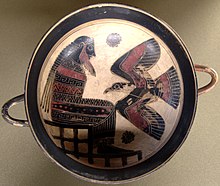Eagle of Zeus


The Eagle of Zeus (
Eagles in antiquity
Eagles were considered the most prominent of birds in classical antiquity. Several legends attested to their unique qualities, such as Aristotle's claim that the sea eagle only raised the young who could look at the sun directly without their eyes watering, or Pliny the Elder's claim that they were immune to being struck by lightning, while the Geoponica claimed that they protected from hail.[1] They were considered endowed with oracular properties, and a divine bird, as messenger of Zeus and herald of victory.[1] In fact, Zeus himself is said to have transformed himself into an eagle on occasion.[1]
From these divine associations, the eagle came to be used as an emblem of several rulers, from the
Legends
There are several schools of thought regarding the origin of this eagle, coming from different Greek legends.
Aëtos
In one version, Aëtos was a childhood friend of Zeus who kept him company while the god was hiding in Crete from his father. After Zeus became king, Hera turned Aëtos into an eagle out of fear that Zeus was in love with him. Zeus made the eagle his most prominent and sacred symbol. In some versions, Aëtos is supplanted with Ganymede, the Trojan whom Zeus abducted in the form of an eagle.[4]
Periphas

According to
Creation of Gaia
In other accounts the eagle was in fact an ancient creation of the goddess
...For so happy an omen, especially since victory did ensue, he made a golden eagle for his war standards and consecrated it to the might of his protection, whereby also among the Romans, standards of this kind are carried. — a translated excerpt from Fulgentius'
Other info
According to others Zeus adopted the eagle when it first appeared to him before the Titan War as a sign of good omen. The eagle was later sent by Zeus to fetch the handsome youth Ganymedes to heaven to become the cupbearer of the gods.
Notes
- ^ .
- .
- ^ "EAGLE OF ZEUS (Aetos Dios) - Giant Eagle of Greek Mythology". www.theoi.com. Retrieved 2022-03-09.
- ^ Kerenyi, Karl (1951). The Gods of the Greeks. London: Thames and Hudson. p. 95.
- ^ Antoninus Liberalis, Metamorphoses 6, pp. 118–121; Cook 1925, pp. 1121 ff..
References
- ISBN 9780415068963
- ISBN 9781108021319.
- Smith, William; Dictionary of Greek and Roman Biography and Mythology, London (1873). "Periphas 5."
- Hemingway, Seán (2015). "The Eagle of Zeus in Greek Art and Literature". In Kevin F. Daly; Lee Ann Riccardi (eds.). Cities Called Athens: Studies Honoring John McK. Camp II. Bucknell University Press. pp. 89–114. ISBN 9781611486186.
